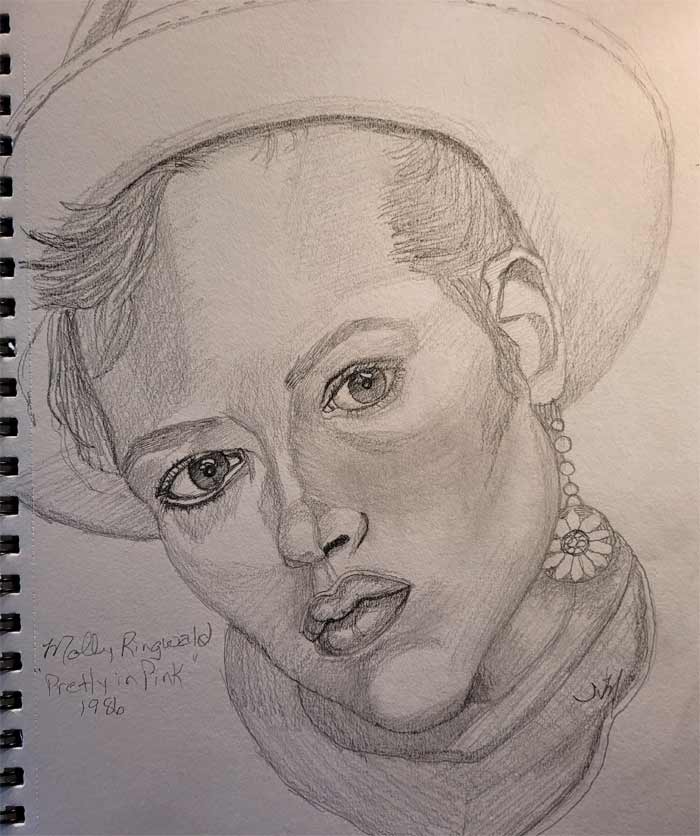Portrait by Molly, Drawing Academy student
Hello,
Thank you for your time. I’m experiencing some problems with rendering my drawings. I feel like I’ve got a handle on the likeness etc. but the rendering is leaving me frustrated. I can’t seem to get the hang of hatching and cross hatching. As you see in my picture it looks too rough and crude. When I blend it looks better to me. However, I know from your course that graphite should not be blended. How to fix this problem?
Thank you.
Artwork critique by Vladimir London, Drawing Academy tutor
Dear Molly,
Thank you very much for your wonderful drawing.
Before rendering an artwork, you need to ensure it has good construction. If you rotate the drawing, so the head is upright, you would notice some mistakes in symmetry with the nose and eyes shifted to one side and the mouth and chin to another. Apart of symmetry, you also need to fix anatomy. For example, the ear has doubtful construction, which is missing the triangular fossa.
Another thing you need to pay attention to is perspective, both linear and aerial. In the three-quarters view, the model’s eye that is farther from a viewer cannot be bigger than another eye. This creates the reverse perspective. Also, the aerial perspective is not present at all. All places have equal attention and lines and tones are done with no regard to proximity to a viewer.
When it comes to rendering tonal values, it is not about blending or tones as such, but above all, constructive drawing. You see tonal rendering as the way to add tones; a professional artist uses rendering as the way to reveal head’s construction. This way, tonal values are sub-product of working on planes, shapes and volumes.
Talking of blending, the area under the model’s eye is the weakest place in this drawing because you smudged graphite and now this spot looks dirty. To avoid mud, it is better to learn how to use pencil strokes to their full potential.
What I can see in your drawing is that you are missing many things that are needed for making great artworks – one of such things is pencil handling skills. The hatching style depends on how well you can draw one line or make a mark on paper. If one line looks weak and out of place, thousands of such lines won’t ad up into beautiful rendering. Because you do not know how to reveal the form with contours, you could not apply pencil strokes along those contours. And having “weak” lines doesn’t solve this challenge.
Here’s just one example – if you take two planes, the frontal plane of the forehead and the side plane of the temple, there will be a border between them, very much like the vertical edge of a cube. Should you draw a cube, you would definitely depict that edge. However, a human head is more round and therefore you do not see planes and therefore do not describe them in drawing.
You have challenges with portrait drawing not because of hatching and cross-hatching, but because you are missing much more fundamental skills of constructive drawing, anatomy, pencil handling, making confident lines with the knowledge of planes and using a well-developed style of lines.
Here’s the thing – your portrait drawings will remain weak and rendering will appear flat until you develop good skills by drawing simpler objects like cubes, cylinders, spheres, prisms and so on. For example, an eyeball has a spherical shape that is enveloped by two eyelids. If you did not spend enough time drawing spheres from life, why do you expect to draw realistically more complex shapes like eyes so they look three-dimensional? This is very apparent in your drawing because you depicted the thickness of the lower eyelid of one eye, which is good, but completely “forgot” about such thickness of another eyelid.
On your own, it would be very difficult if not impossible to learn all that is needed to become a professional artist. I do not know a single great artist in the entire history of arts who was self-taught. If you are serious about getting strong drawing skills, you can consider the Life Drawing Academy Correspondence Course.
Today, this is the most advanced and the cheapest art course available on the Internet that comes with personal lifetime tutoring for a one-time low fee.
Kind regards,
Vladimir London
Art tutor





